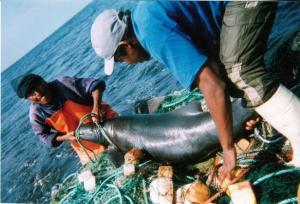Joanna Alfaro-Shigueto
Other projects
25 Jun 2009
Experimental Trial of Acoustic Alarms to Reduce Small Cetacean by Catch by Gillnets in Peru
The study will assess the effectiveness of a cetacean capture ban by estimating mortality levels of different fishing gears, will seek ways to reduce captures, and will provide fishermen dolphin conservation information.

Entangled dusky dolphin in a gillnet for sharks and rays.
International legal measures to ban the take of dolphins and porpoises in fisheries have served as a protective measure to reduce declines of cetacean populations. However, cetacean bycatch remains a concern for fisheries worldwide and artisanal fisheries may contribute significantly to cetacean mortalities at sea.

In Peru, the bycatch of small cetaceans peaked in the late 1980’s and early 1990’s. From 1990-1993, approximately 17,000 dolphins and porpoises were caught in Peruvian artisanal fisheries. National legislation passed in 1995 prohibits dolphin and porpoise capture, trade and consumption. However, this legislation is not fully enforced in some ports. Also, the highly diffuse nature of artisanal fisheries and their unregulated markets has made difficult the assessment of the effectiveness of dolphin and porpoise protection legislation. This knowledge gap makes decision making difficult and, as a result, conservation and enforcement efforts in this field are limited. Nevertheless, updated data on numbers of cetaceans caught and the spatial and temporal distribution of cetaceans and bycatch are essential in defining the scale of this continuing problem and in designing appropriate national and regional management and conservation measures.
Species affected, some of which are listed as global priorities for cetacean bycatch reduction, include Burmeister’s porpoises Phocoena spinipinnis (whose distribution is limited to Peru, Chile and Argentina), dusky dolphins Lagenorhynchus obscurus, common bottlenose dolphins Tursiops truncatus, and long-beaked common dolphins Delphinus capensis.
In attempting to address this situation this study has three main objectives: (1) assess the effectiveness of legal bans on small cetacean protection through an observer program in three fishing ports, (2) increase local awareness of marine mammal conservation by conducting workshops with fishermen and fishing authorities, and (3) test acoustic devices (pingers) as a means to reduce or mitigate dolphin bycatch. The study will provide valuable insights into the level of success of a ban on the take of marine species that is in conflict with local fishing practices. It will also promote greater awareness and involvement by local fishermen and will provide useful information on the potential for the application of bycatch mitigation measures. Moreover, we hope the study draws attention to marine fauna interactions with small/medium scale fisheries (often overlooked globally) and will show that these fisheries can be effectively monitored.